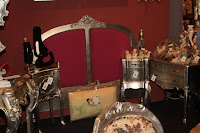 The Battle of Almansa was an important battle during the War of the Spanish Succession. It was fought on 25th April 1707. Almansa is about 50 minutes from Culebrón.
The Battle of Almansa was an important battle during the War of the Spanish Succession. It was fought on 25th April 1707. Almansa is about 50 minutes from Culebrón.The commentator was really positive. "Just look at that rainbow, how beautiful, one of the best I've ever seen!" True enough. Mind you he was in a nice cosy and dry caravan whilst we were suddenly in fear of drowning to death sitting in the stands. We found the beauty of the rainbow hard to appreciate.
When the Spanish Habsburg King Carlos II died in 1700 he left no direct heir. There were two rival claims to the throne - the Hapsburgs, through the Archduke of Austria and the Bourbons, through the French King. We British backed the Austrian claim but several European powers weighed in behind one side or the other. Between 1701 and 1714 battles raged all over Europe and in North America and there were even some skirmishes in the Caribbean.
At the Battle of Almansa, just outside Almansa in Castilla la Mancha, the Duke of Berwick, the illegitimate son of James II of England serving in the French Army, beat the French Henri de Massue, leading British troops. Odd eh?
In the end the British were on the losing side but the Treaty of Utrecht signed near the end of the war handed Gibraltar over to the British. We're still there.
According to that same commentator the participants in this re-enactment, still something relatively unusual in Spain, had come from several European countries just as in the real battle. The Russians and Ukranians had apparently driven all the way. The Irish had brought their horses. Shame it rained quite so much.
.












